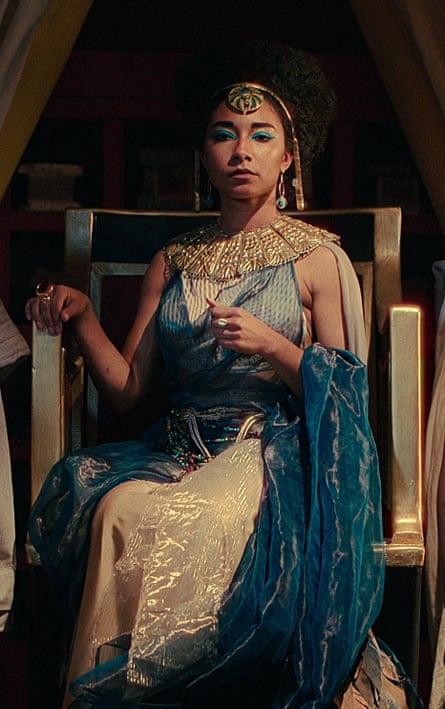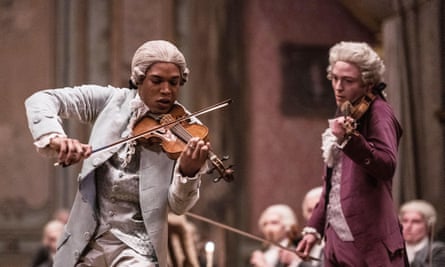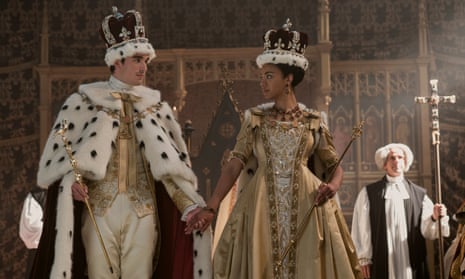Fantasy collided with reality last month, when the Black British actor Adjoa Andoh, who plays Bridgerton’s Lady Danbury, was invited by ITV to commentate on King Charles’s coronation. Andoh described the lineup of waving royals on the Buckingham Palace balcony as “terribly white”. With the family’s solitary person of colour – the Duchess of Sussex – conspicuous by her absence, Andoh was technically correct. Even so, the comment prompted the highest number of complaints to Ofcom of any broadcast this year.
Perhaps Andoh had lost sight of the yawning gap between fiction and fact. Shows such as Netflix’s Bridgerton have been applauded for introducing actors of colour into the “terribly white” space of costume drama, but some people remain resistant to anything that upsets their ideas of the past (even if those ideas were largely gleaned from costume dramas).
We’ll come back to Bridgerton. In the meantime, another new show has had people up in arms: Queen Cleopatra, a Netflix docuseries co-produced and narrated by Jada Pinkett Smith. Its sin was to cast a Black actor as the Egyptian ruler: Britain’s Adele James, who is mixed race. Cleopatra has been portrayed many times by white actors, including Vivien Leigh, Elizabeth Taylor and Monica Bellucci, but this supposed “blackwashing” was too much for some – and not just the usual suspects. Egypt’s antiquities minister, Zahi Hawass, complained: “This is completely fake. Cleopatra was Greek, meaning that she was light-skinned, not black.” One Egyptian lawyer even sought legal action to block Netflix in the country for its promotion of “Afrocentric thinking”.

Cleopatra’s precise pigmentation is up for debate: she was descended from the Greek-Macedonian Ptolemaic dynasty. But, the show’s makers argue, the dynasty may have intermarried with local Egyptians over the preceding 250 years, at a time when no one was classified as “black” or “white” anyway. “Why shouldn’t Cleopatra be a melanated sister?” asked Tina Gharavi, the show’s director. “And why do some people need Cleopatra to be white? Her proximity to whiteness seems to give her value, and for some Egyptians it seems to really matter.”
Queen Charlotte, the latest Bridgerton instalment, hangs on a similar scrap of historical speculation: the theory that German-born Charlotte of Mecklenburg-Strelitz had African ancestry. Thus, young Charlotte is portrayed by British actor India Amarteifio, who has Ghanaian and German ancestry. “I know there are a lot of people who believe it’s absolutely fact that she’s from Black Portuguese royalty,” said the show’s creator, Shonda Rhimes. “The idea that that would make her their first Black royal was very interesting to me.”
Queen Charlotte begins with the disclaimer that it is “fiction inspired by fact” and that “all liberties taken by the author are quite intentional”. There turn out to be quite a lot of liberties. This prequel chronicles Charlotte’s arranged marriage to George III in 1761, which blossoms into real love and ushers in a new era of racial unity in Britain – just like Harry and Meghan didn’t.
The Bridgerton extended universe has always taken a curious approach to race, but in Queen Charlotte it reaches bizarre levels. This parallel 18th-century Britain contains many wealthy Black people, such as the young Lady Danbury and her older, buffoonish, darker-skinned husband (who some have condemned as a racial caricature). These rich Black Britons went to Eton and Oxford, we’re told, but are excluded from white aristocratic society.
Charlotte and George’s union prompts what is dubbed “the great experiment” – bestowing upper-class titles and acceptance upon these posh people of colour, and thereby bridging Britain’s racial divide. Racism is vanquished overnight, within the space of a formal dance to a string arrangement of an Alicia Keys track. “With one party,” George tells Charlotte, “we have created more change, stepped forward more than Britain has in the last century.”
It wasn’t quite like that in the real world. There were between 10,000 and 20,000 Black people in Britain in the 18th century, but vanishingly few were wealthy. They were primarily men, mostly sailors, soldiers from the American revolutionary war – who were promised emancipation in return for fighting for the British – or servants working in the households of white people.

Bridgerton doesn’t really do “poor”, but the real elephant in the ballroom is slavery. At the time Queen Charlotte takes place, the brutal mechanics of the slave trade were in full swing. The abolitionist movement was just getting started, but the slave trade was not legally abolished in the British empire until 1807, and slavery itself not until 1833. During George III’s reign, 1.5 million Africans were captured and shipped to plantations in North America and the Caribbean. In 1800, the slave trade made up more than 10% of Britain’s GDP. These are the ill-gotten riches on which Bridgerton’s (and Britain’s) world of palaces, parties and gigantic wigs was built, but in the show itself, this side of the story is ignored. There are a few tiny references to “the colonies”, but slavery, human rights and abolition are never mentioned.
“It’s an absurd take on Black history,” says Steven I Martin, Black British author and historian. “It is set at a time when Britain was the largest trader in human lives on the planet. Slavery was central to the British economy.” Martin accuses Bridgerton of “inviting, or fomenting, the forgetting or overlooking of the realities of that period”.
Martin finds Bridgerton’s race fantasy problematic for other reasons: “There are no other groups to which this absurdity would be applied,” he says. “I often offer the example of having a series set in the Germany of the 1930s – all ethnically harmonised simply because the Führer married, say, a woman of Jewish background. It would just be laughed out. Somehow this – having people of African origin, expecting us to be happy with this twisted image of ourselves – seems to be acceptable. I find it really, really uncomfortable.”
Yet the Bridgerton franchise has been hugely successful all over the world – third and fourth seasons are in the works. For BAME viewers, it is refreshing to see people of colour in aristocratic finery, rather than the rags of servants and enslaved people. For white viewers, it’s colonial history without the racial baggage – all the gilt, none of the guilt.
The “Bridgerton effect” has brought more characters of colour into the zone of historical drama. In addition to Queen Cleopatra, we’ve recently had ITV’s Sanditon, extrapolated from an unfinished Jane Austen novel, which includes a central Black character who has inherited the fortune of her white, plantation-owning father. ITV’s new adaptation of Tom Jones has also featured people of colour.
“My concern is that everyone now starts putting Black characters into their productions in ways that reflect our current interests, but that undermine the actual history,” says Gretchen Gerzina, historian and author of Britain’s Black Past. “So much so that people believe that this was the actual history. That’s the great danger. It gives people a pass to say, ‘Oh, it was all right. They didn’t suffer and they were wealthy.’”

Alternatives are available. One is the now-widespread practice of colour-blind casting, where race is ignored entirely and actors are cast purely on how well they fit the role. This has been done on the stage for decades, particularly with Shakespeare – Anglo-Indian Ben Kingsley played Hamlet in 1975 and Adrian Lester played Henry V in 2003. More recently, the practice has made its way into cinema, as in Armando Iannucci’s 2019 film The Personal History of David Copperfield, where the eponymous character was played by Dev Patel, or Joel Coen’s 2021 The Tragedy of Macbeth with Denzel Washington.
Colour-blind casting is a way of saying: “These characters may not have been Black or brown but who really knows? And who really cares?” All historical drama is a construct made in the here and now, and all pretensions to “accuracy” are at best approximate. Cleopatra did not speak in English, after all, and Georgian Britons often had bad skin and terrible teeth.
The other alternative is to seek out true stories of people of colour who lived in these eras. One example is Amma Asante’s 2013 film Belle – a biopic of Dido Belle, who was born into slavery in the year of George and Charlotte’s marriage, and was raised as an aristocrat in 18th-century London. Another has just hit British cinemas: Chevalier, based on the life of Joseph Bologne, AKA the Chevalier de Saint-Georges, the illegitimate son of a French aristocrat and an enslaved African woman. Bologne’s story seems too extraordinary to be true. Born in 1745 and educated in France, he became a champion fencer, a skilled horse-rider, ice skater, swimmer, dancer, as well as a gifted composer and violinist. US president John Adams declared him “the most accomplished man in Europe”.
In the film’s opening scene, the young Bologne, played by Kelvin Harrison Jr, outclasses Mozart in a violin duel. That probably never happened. But, unlike Bridgerton, Chevalier stays true to the racial realities of 18th-century France. Bologne was given the title Chevalier de Saint-Georges by Louis XV and became a music tutor to Marie Antoinette, but despite his attempts to assimilate, he was never truly accepted. He applied to lead the prestigious Paris Opéra, but some of its star singers said they would never “submit to the orders of a mulatto”.
There is a touch of Bridgertonian romantic intrigue to the film, it must be said, but some artistic licence is understandable, if not essential. Documentation of Bologne’s life is far from complete. In fact, it was actively suppressed: in 1802, Napoleon Bonaparte banned performances of his compositions, and his name was all but erased from musical history until recently.
It is a similar story with many other Black European histories: they were either lost, forgotten or never considered worthy of record. When Gerzina was researching her book 26 years ago, she asked an assistant at a prominent London bookshop if they had Peter Fryer’s Staying Power, a seminal history of Black people in Britain. “She just looked at me and said, ‘Madam, there were no Black people in England before 1945.’” The picture is being filled in, though. Researchers are uncovering ever more about Black British lives, many of which would be worthy of a movie. Nathaniel Wells, for example: born in Saint Kitts to a white father and a Black mother, he inherited his father’s Welsh estate in 1794 and became a magistrate, even as he continued to run slave plantations in the Caribbean.
Rhimes herself has evoked this forgotten history in reference to Bridgerton: “There were so many successful Black composers; lots of rich African people sent their children to England for boarding school,” she said in a recent interview. “Those things existed, and I was amazed to find they did. What I wanted to explore was, what happens if you unerase that erased history?”
“Erasing history” has become a contentious phrase in today’s culture wars. Attempts to bring Black history to light are still being resisted and suppressed. The BBC was recently accused of “rewriting British history to promote a woke agenda” – for example, for making content about histories of enslavement. But when people campaigned against statues associated with Britain’s slave trade, such as that of Edward Colston, which was ceremoniously chucked into Bristol harbour in 2020, critics including Boris Johnson argued that this was “erasing history”. Similar arguments took place over the removal of Confederate statues in the US, even as the American right has been enacting draconian book-banning and syllabus-shaping legislation to inhibit wider knowledge of Black (and brown and queer) histories – erasing history.
But overwriting the actual history with more fanciful versions could also be seen as a form of erasure. At a time when forces are invested in suppressing Black history, shows such as Queen Charlotte could be playing into their hands. “Because we’re primarily a visual culture nowadays,” says Martin, “in terms of information and the stories we tell about ourselves and each other, the phenomenon of Bridgerton means that the template has been set in terms of what the public expects and demands. So a lot of fantastic, ordinary, everyday heroic people will find their stories pushed into the background – in favour of glamour and beautifully dressed lords and ladies.”
This article was amended on 12 June 2023 to correct a reference to the abolition of slavery. It was the slave trade that was abolished in the British empire in 1807, not slavery itself.
Chevalier is in UK cinemas now.
